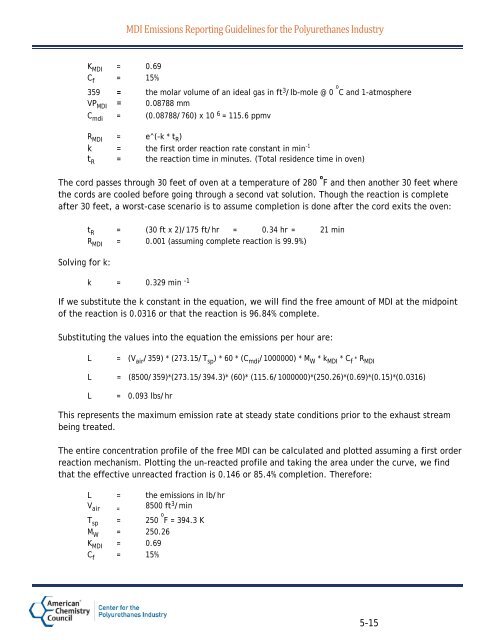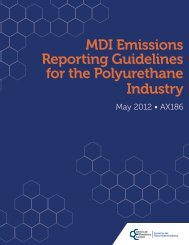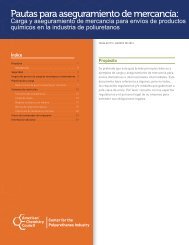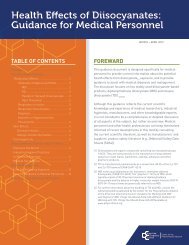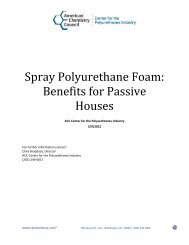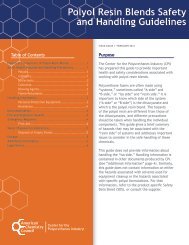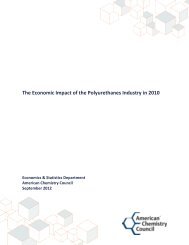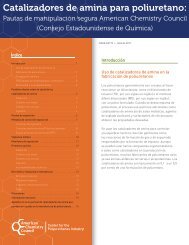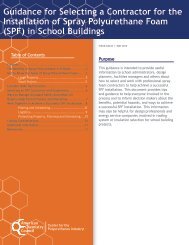MDI Emissions Reporting Guidelines for the ... - Polyurethanes
MDI Emissions Reporting Guidelines for the ... - Polyurethanes
MDI Emissions Reporting Guidelines for the ... - Polyurethanes
You also want an ePaper? Increase the reach of your titles
YUMPU automatically turns print PDFs into web optimized ePapers that Google loves.
K <strong>MDI</strong> = 0.69<br />
C f = 15%<br />
<strong>MDI</strong> <strong>Emissions</strong> <strong>Reporting</strong> <strong>Guidelines</strong> <strong>for</strong> <strong>the</strong> <strong>Polyurethanes</strong> Industry<br />
359 = <strong>the</strong> molar volume of an ideal gas in ft 3 /lb-mole @ 0 o<br />
C and 1-atmosphere<br />
VP <strong>MDI</strong> = 0.08788 mm<br />
C mdi = (0.08788/760) x 10 6 = 115.6 ppmv<br />
R <strong>MDI</strong> = e^(-k * t R )<br />
k = <strong>the</strong> first order reaction rate constant in min -1<br />
t R = <strong>the</strong> reaction time in minutes. (Total residence time in oven)<br />
The cord passes through 30 feet of oven at a temperature of 280 o<br />
F and <strong>the</strong>n ano<strong>the</strong>r 30 feet where<br />
<strong>the</strong> cords are cooled be<strong>for</strong>e going through a second vat solution. Though <strong>the</strong> reaction is complete<br />
after 30 feet, a worst-case scenario is to assume completion is done after <strong>the</strong> cord exits <strong>the</strong> oven:<br />
Solving <strong>for</strong> k:<br />
t R = (30 ft x 2)/175 ft/hr = 0.34 hr = 21 min<br />
R <strong>MDI</strong> = 0.001 (assuming complete reaction is 99.9%)<br />
k = 0.329 min -1<br />
If we substitute <strong>the</strong> k constant in <strong>the</strong> equation, we will find <strong>the</strong> free amount of <strong>MDI</strong> at <strong>the</strong> midpoint<br />
of <strong>the</strong> reaction is 0.0316 or that <strong>the</strong> reaction is 96.84% complete.<br />
Substituting <strong>the</strong> values into <strong>the</strong> equation <strong>the</strong> emissions per hour are:<br />
L = (V air /359) * (273.15/T sp ) * 60 * (C mdi /1000000) * M W * k <strong>MDI</strong> * C f * R <strong>MDI</strong><br />
L = (8500/359)*(273.15/394.3)* (60)* (115.6/1000000)*(250.26)*(0.69)*(0.15)*(0.0316)<br />
L = 0.093 lbs/hr<br />
This represents <strong>the</strong> maximum emission rate at steady state conditions prior to <strong>the</strong> exhaust stream<br />
being treated.<br />
The entire concentration profile of <strong>the</strong> free <strong>MDI</strong> can be calculated and plotted assuming a first order<br />
reaction mechanism. Plotting <strong>the</strong> un-reacted profile and taking <strong>the</strong> area under <strong>the</strong> curve, we find<br />
that <strong>the</strong> effective unreacted fraction is 0.146 or 85.4% completion. There<strong>for</strong>e:<br />
L = <strong>the</strong> emissions in lb/hr<br />
V air = 8500 ft 3 /min<br />
T sp = 250 o<br />
F = 394.3 K<br />
M W = 250.26<br />
K <strong>MDI</strong> = 0.69<br />
C f = 15%<br />
5-15


